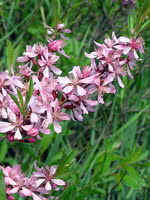Mon-Fri 9am - 5pm Mountain time
Russian Almond vs Hairy Golden Aster
Prunus tenella
Heterotheca villosa
NOT AVAILABLE THIS SEASON - MIGHT RETURN
Russian Almond is a low maintenance, short, slightly suckering shrub. It is covered with attractive, bright pink flowers in early spring before its foliage emerges.
This hardy species forms dense thickets attracts wildlife. Russian Almond prefers full sun and well-drained soils, but can tolerate moist soils.
The nuts it produces are quite attractive but very small. They are bitter and possibly toxic in large quantities.
Check out our YouTube channel video of the Russian Almond here.
Hairy Golden Aster is a native perennial wildflower known for its clusters of bright yellow, daisy-like blooms. They bloom from mid-summer into fall, providing late-season colour and a valuable nectar source for pollinators, including a variety of bee species.
Flowers mature into fluffy seed heads and can self-seed readily. Removing spent blooms helps manage their spread, but some people will choose to leave a few seed heads to provide food for birds. Hairy Golden Aster grow in bushy clumps, tolerates poor sandy soils, and once established, are among the most drought-tolerant wildflowers. They are well-suited for pollinator gardens, restoration, naturalization, and xeriscaping projects.

